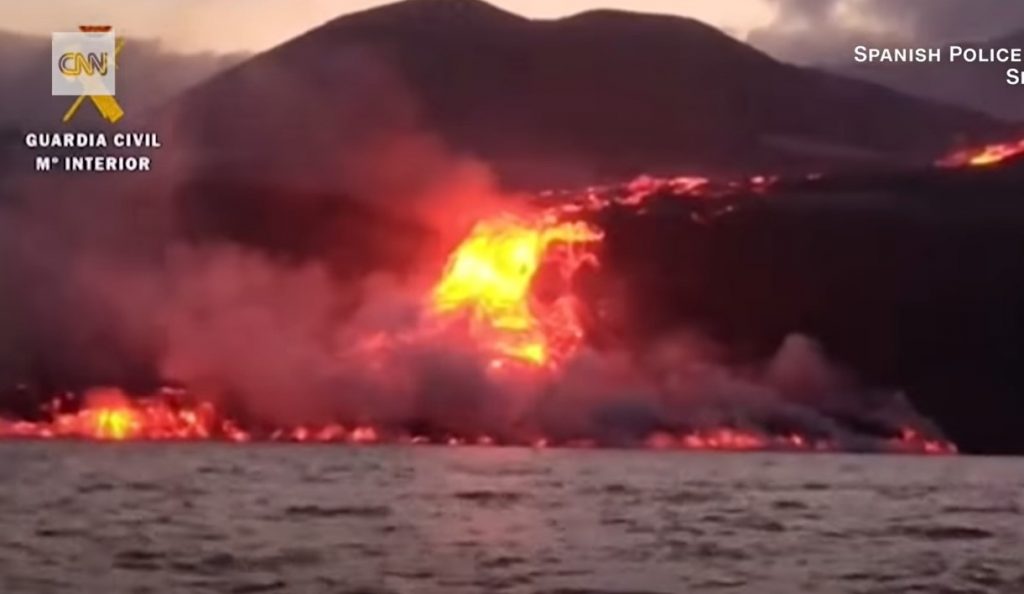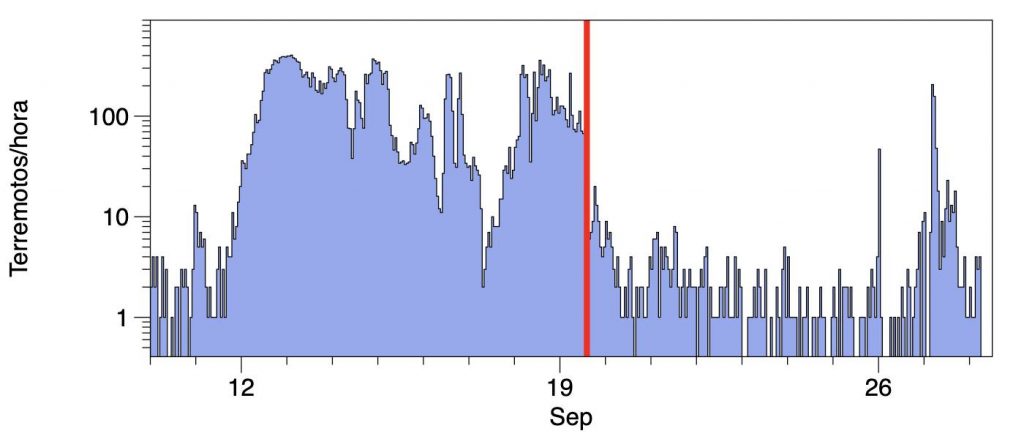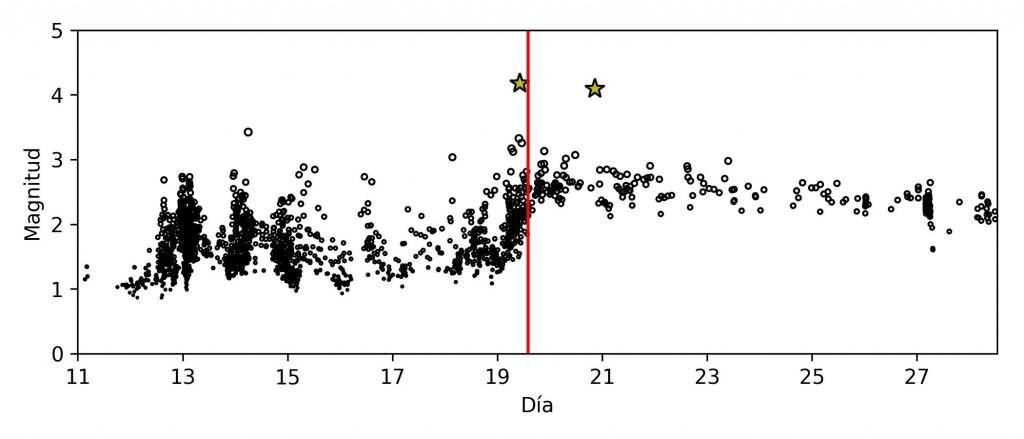
Lava from La Palma volcano is pouring continuously into the sea. According to new calculations, the magma, which first came int contact with the water yesterday evening around 11p.m. local time, has already covered between 5 to 10 hectares of the sea, building a new, 50-meter-high pyramid-shaped island.
Entrada de la colada de lava al mar. Vídeo grabado por nuestros compañeros / Entry of the lava flows into the sea. Video recorded by our colleagues #lapalma pic.twitter.com/zMW2x1zenD
— INVOLCAN (@involcan) September 29, 2021
The new delta formed by the lava is about 500 meters wide and has even changed the colour of the surrounding water – from turquoise to brown.
Look at the height of this new lava island!
Monitoreo del primer contacto de la lava con el medio marino. Buque oceanográfico #RamonMargalef @IEOoceanografia @CSIC pic.twitter.com/g3fiKsIA6E
— Eugenio Fraile (@EugenioFraile) September 29, 2021
Meanwhile, on the island, the molten rock has destroyed more than 744 buildings, as well as 21.5 kilometers of roads. On Wednesday there were major concerns about the connecting roads in the south of La Palma, such as those serving Puerto Naos and La Bombilla. Moreover, 476 hectares of land was buried.
According to a calculation by the real estate website Idealista, the cost of the destruction in terms of homes and plots of land could be as high as €206 million.
Los últimos datos del #Pevolca a miércoles, 29 de septiembre, apuntan que ?
➡ La erupción ha afectado 476 hectáreas aproximadamente, en las que se encuentran un total de 744 construcciones .
➡ 185 personas se encuentran evacuadas y se alojan en el hotel de Fuencaliente.— Cabildo de La Palma (@CabLaPalma) September 29, 2021
For now, the eruption of the volcano on La Palma “has not affected the air quality, which is perfectly breathable,” according to the island council, which added that measuring equipment had not detected any gases that could be dangerous to people’s health. Despite these good news, the council requested that residents of Tazacorte stay inside their homes, should any toxic gas be emitted and drifted over the island as the lava flows into the ocean.
This could have however turned really bad if the Guardia Civil hadn’t rapidly removed 10 tons of chemicals, ammonium nitrate and sulphur, that were lying less than 90 meters from the volcanic lava in La Palma.
? La Guardia Civil extrae 10 toneladas de productos químicos, como nitrato amónico, azufre y otros componentes fitosanitarios, de un almacén que se encontraba a menos de 90 metros de la lava del volcánhttps://t.co/XwbSfOnx7y pic.twitter.com/BMwQb5PKiD
— Radio Club Tenerife (@radioclubSER) September 29, 2021
After several days of deceleration, the lava reactivated on Sunday, speeding up its journey toward the sea. Until that point, the eruption had been strombolian, characterized by large explosions and a slow lava flow. At the start of the week, however, much more fluid lava started to emerge from the volcano, speeding up the arrival of the molten rock into the sea.
How is seismicity evolving under the volcano?
In the week leading up to the eruption there was a very intense seismicity on La Palma Island culminating in a 4,2-magnitude earthquake recorded on Sunday, September 19 at 11:16 p.m. Canary Time.
The following figures show the number of earthquakes automatically detected every hour and the magnitudes of seismic events that could be located.


After the eruption, marked by a red line, there is a marked decline in the number of earthquakes detected.
However, that does not reflect a true decline in seismicity, but a lower ability to detect smaller earthquakes due to the strong signal of volcanic tremor that hides lower-magnitude earthquakes.
Since last September 10, the Canary Seismic Network has detected, on La Palma Island, about 29.000 earthquakes and located 1.754 of them, 19 in the last 24 hours.
In recent days, the hypocenters of localized earthquakes were generally at a depth of about 10 km, the same observed in the days leading up to the eruption. That may indicate new input of magma. It may also indicate that these earthquakes could be linked to an in-depth magmatic reservoir adjustment due to a decrease in pressure after expelling the magma content inside during the eruption.
Los terremotos de las últimas 24 h aparecen en rojo, mientras que los dos terremotos con magnitud superior a 4,0 aparecen como rombos amarillos / The earthquakes of the last 24 h appear in red, while the two earthquakes with a magnitude greater than 4.0 appear as yellow diamonds
— INVOLCAN (@involcan) September 29, 2021
From the earthquakes located since yesterday, 6 have exceeded M3.0 and 7 have been felt. In other words, tremors remain stable and have medium amplitudes. Meanwhile, the sulphur dioxide emission rate has increased reaching 10,757 tons per day.
What happens when lava enters the sea?
The lava flow from the La Palma volcano, in Spain’s Canary Islands, is a bomb for the sea. It’s not just because of the explosions created by the hydrothermal and chemical reactions, but also because it will dramatically change the coastline conditions.
The first reaction is thermal. Tons of rock with a temperature of over 1,000ºC are falling into a body of water where the average temperature is 23ºC. The second reaction, which comes immediately after the first, is chemical and involves the contact between the components of the lava, the water and the sea salts made of sodium chloride.
In order to know the long-term consequences of this contact between the lava and the sea, it is useful to look at past research on similar events. The most recent one was conducted by the IEO when there was a submarine eruption in the nearby island of El Hierro from October 2010 to March 2011. That eruption created a large amount of magma and gases, but, as Tomás Vázquez noted, the interaction with the water was immediate, while in the case of La Palma, this contact is not directly with the seabed but with the more superficial layers of the sea.
The water conditions will change substantially: the temperature and acidity will rise as a result of emissions of carbon dioxide, carbonic acid and sulfuric acid. The IEO geologist noted that in the case of El Hierro, these alterations were quite significant because “all the gas emissions were underwater.”
There will also be alterations to the concentration of metals such as iron, copper, cadmium and mercury, as well as an increase in carbon dioxide emissions and a reduction in oxygen – in El Hierro, this reduction was nearly absolute according to some measurements. Levels are not expected to be the same in La Palma, where the lava is dropping down into the sea from a cliff. Mario Lebrato, of the Geosciences Institute at Kiel University in Germany, said that “these fluids do not react the same way as in deep water systems.”
The water conditions will change substantially: the temperature and acidity will rise as a result of emissions of carbon dioxide, carbonic acid and sulfuric acid.
In a study published in the journal Science, Samuel Wilson looked at the impact of the entry of lava into the sea following the eruption of Kīlauea volcano in Hawaii in 2018, and found that this event fueled large phytoplankton blooms in nearby waters. These lasted during the two-month-long eruption and rapidly dissipated when the lava stopped flowing. The cause, according to Wilson, was the “unexpectedly high concentrations of nitrate and rise in temperatures.”
Changes in the environment due to the entry of lava can also push species to temporarily flee the area until the sea returns to its normal levels, while a rise in water acidity can lead to the death of marine life. Tomás Vázquez added that “the temporary rise in temperature is very harmful to species that are used to a very specified range of temperatures.” He explained: “Some try to flee before the lava arrives, as soon as they detect that the water temperature is changing.”
In the El Hierro study, the Biodiversity, Marine Ecology and Conservation (Bioecomac) research team detected sediments of ash and substances from the sulfur that were brought in by the tide and storms; the appearance of new organisms; transitory changes in the species of dominant algae and a rise in mollusks and invertebrates whose larvae survived the temporary changes and benefited from the drop in predatory pressure from fish that had left the area or died. When the sea conditions improved, the fish returned and took advantage of the greater plankton numbers.
The geologist from the IOE said that researchers will also look at how the lava affects benthon, the organisms that live near the sea bottom. “These always take a bit longer to repopulate, but for planktonic organisms, it will be easier to colonize the area again.”
Recovery times are uncertain, but there is cause for optimism. A 10-year study on an area affected by a volcano and published in Scientific Reports concluded that “the sudden and catastrophic changes observed […] profoundly reshaped biogeochemical processes in shallow and offshore waters for one year, but they remained transient in nature, with a possible recovery of the system within two years.”
Yes, we are just at the beginning of this eruption and its effects will be devastating fore sure… [El Pais, El Pais]
Now subscribe to this blog to get more amazing news curated just for you right in your inbox on a daily basis (here an example of our new newsletter).
You can also follow us on Facebook and/ or Twitter. And, by the way you can also make a donation through Paypal. Thank you!
You should really subscribe to QFiles. You will get very interesting information about strange events around the world.













Good work by Guardia Civil for removing hazardous chemicals!
???????
There’s that new real estate opportunity
—adding mass to the island via lava flows.
??
https://www.thegatewaypundit.com/2021/09/former-notre-dame-professor-said-damn-unvaccinated-dies-two-weeks-receiving-3rd-covid-shot/
Damn the unvaccinated she said. This isn’t an isolated case either. Wait until more people red pill themselves. I’m seeing liberals wake up too, which is interesting. We can only hope it happens rapidly.
https://www.thegatewaypundit.com/2021/09/joe-suck-biden-booed-loudly-congressional-baseball-game-washington-dc-video/
An eruption of Boooo’s for biden. 81,000,000 people supposedly voted for this clown?
https://www.infowars.com/posts/demonic-dems-call-abortion-a-blessing-act-of-love-as-they-protest-texas-abortion-law/
Molech worshippers, either wittingly or unwittingly, are repulsive creatures.